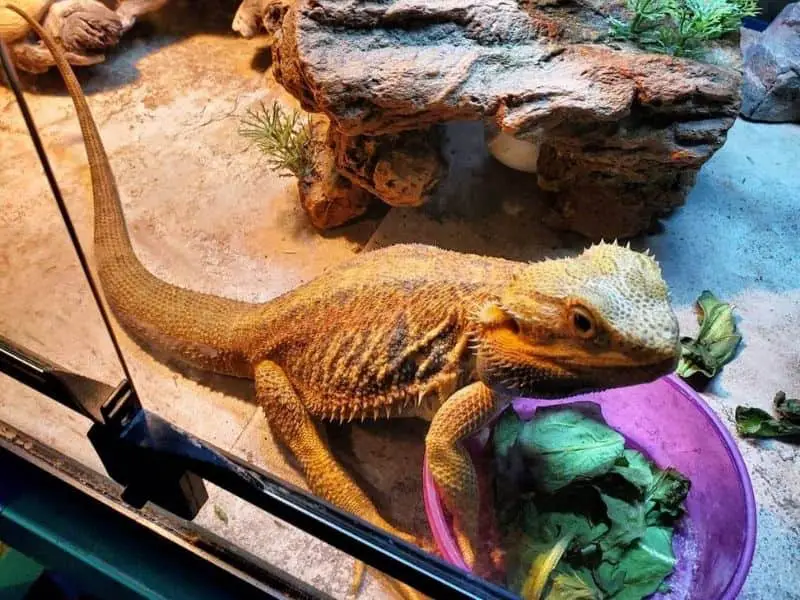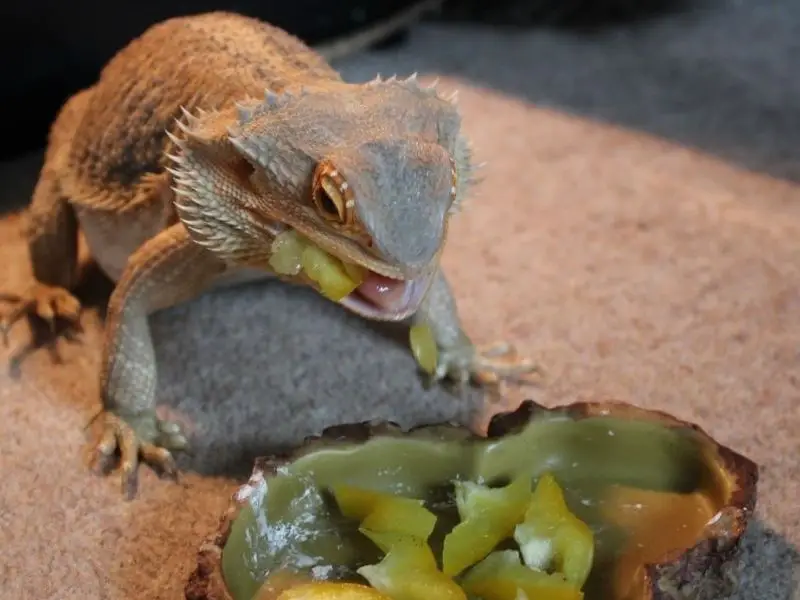One of the most frustrating things that can happen to a bearded dragon owner is when their pet won’t eat. There are many causes for this, but the good news is there are also tons of ways to help your bearded dragon get back into its eating routine!
In this article, we will discuss some of the most common reasons why a beardie might not want to eat and what you can do about it. We’ll also provide you with some tips on how to keep your bearded dragon healthy while waiting for them to start eating again.
Reasons why your Bearded Dragon is not eating

Many people think that their bearded dragon isn’t eating because they are too young or old, but in reality there are many other reasons why a bearded dragon won’t eat.
Here are reasons why your bearded dragon is not eating:
Stress in its environment
Bearded dragons are sensitive animals, and stress can cause them to refuse food. Some examples of what might make your beardie stressed include:
- -Being in an unfamiliar environment with new people or pets around
- -Having recently undergone surgery without anaesthesia (this includes being handled too much)
- -Moving into a different cage or home while not eating well during the process/getting used to their new surroundings
- -Receiving a big fright from something like fireworks going off nearby or suddenly coming upon some other loud noise that makes them jump.
The more surprises there are, the higher likelihood it will trigger anxiety behaviors such as refusing food for fear of getting startled again. It’s also common for bearded dragons that have been bullied by others or frightened by another animal to refuse food.
If you’re concerned about any of these things and your bearded dragon still isn’t eating well after making sure they are in a secure environment with people, you might want to call a reptile vet to check on your pet.
2. Dehydration (from not drinking enough water)
Dehydration happens when a bearded dragon doesn’t drink the water that’s available to them. This can happen for many reasons, but most animals don’t like drinking if they are sick or in pain or feeling stressed out from too much noise and activity nearby.
The first thing you’ll want to do is make sure your bearded dragon has fresh food and clean water every day. The next step would be to provide an environment with plenty of cool places where they could escape into privacy if needed – this might mean adding some rocks or tall plants around their cage so there are more hiding spots available instead of being right up against the walls all the time.
When the lizard will feel safe, it will start to drink and eat again, so make sure the environment is safe for the gecko to quench its thirst and start eating again.
3. Poor lighting
Poor lighting can also cause a bearded dragon not to want food. Bearded dragons need UVB light from fluorescent tubes in order to produce vitamin D that aids in digestion, which allows them not only to stay healthy but also really enjoy mealtime!
Light and temperature are so important to bearded dragons that they can’t do without them. A simple fix is moving the light closer or farther from your pet’s enclosure.
If you’re not sure if it has enough light, use a digital thermometer and check its temperature against what is recommended (usually 78-80°F). If one of these two needs adjusting, don’t wait too long. When temperatures drop below 70°F for more than 24 hours, bearded dragons will stop eating because they know something is wrong with their living conditions.
Note: This is what happens when you don’t supply enough light: Vitamin D deficiency – which leads to Metabolic Bone Disease (MBD) or Hypocalcemia (calcium deficiency in beardies). The result is stunted growth, seizures, and maybe even death.
4. Brumation
Brumation is a natural process that bearded dragons do during the winter months in order to hibernate, and it usually begins around October. During brumation, a dragon will stop eating as much but you still need to give them light because they’re not getting any from the sun.
Signs of brumation include:
- – beardie’s appetite will decrease
- – they’ll stop basking in the sun and spend most of their time sleeping or resting
- – you might notice a change in behavior such as more aggression with other dragons
- -brumating dragons can also have less interaction.
Note: Brumation should last no longer than 12 weeks before being interrupted by warmer temperatures or an artificial light source. If not then there could be even worse consequences like metabolic bone disease which leads to stunted growth, seizures, and maybe even death.
5. Impaction
Impaction in bearded dragons is when the bearded dragon’s digestive system becomes blocked. This can occur when the food particles in the gut are too large and they get stuck, preventing them from getting digested properly. Impaction often occurs when bearded dragons swallow something too big (like a big cricket).
Sometimes impaction is caused by a foreign object that was swallowed whole or it could be because of an incomplete shedding process where some skin got left behind in the mouth during molting.
Impaction usually occurs at one end of the colon (the lower part) which forces other material to go up into different areas like lungs, throat, esophagus, and mouth causing choking or asphyxiation which will eventually kill your bearded dragon if not corrected quickly enough.
A vet visit should be scheduled right away so you can determine what type of impaction has occurred with your pet. The vet will take the right action to help your bearded dragon start eating again.
6. Age-related loss of appetite
Another reason why your Bearded dragon won’t eat is because it is too old. A bearded dragons life span ranges from five to twenty years, but they typically live sixteen or so years on average. As the dragon gets older it will become weaker and might not have the energy to stay active and eat as much as it used to eat while young.
That said, if your dragon has been eating well up until this point, you should take note of their age because they may be nearing death’s door and slowing down due to age-related illness or disease.
If your beardie won’t eat because of old age, don’t worry about feeding them more than usual just yet as this could risk overexerting him/her further in his weakened state, which can cause severe injury to the mouth and gut.
If your beardie isn’t eating as much as before, it is also possible that it has stopped growing and probably doesn’t need as much food as it did when it was young and actively growing.
7. Mouth injuries
Sometimes a bearded dragon will refuse food because they have an injury in their mouth. The injury can range from having a tooth knocked out to cracking the bone under their tongue or on the roof of their mouth and not being able to eat as much as before.
Injuries can be caused by a fall, collision with another animal, or an object. Check the lizard’s mouth for signs of injury by opening their mouth and looking in. If there is injury, see a veterinarian for treatment as soon as possible.
Mouth injuries should be treated as soon as possible to avoid infection. Your reptile pet will lose weight and fat pads really fast if they don’t eat for a long time.
8. Temperature problems
Some reptiles, including bearded dragons, may lose interest in eating due to changes in temperature such as moving from a warm house into cold weather conditions outside.
This is especially true if it was previously been acclimated to hot temperatures indoors. Temperatures that are too high or too low can stop the digestive system from working.
The best thing to do is provide a temperature gradient that gradually changes between hot and cold temperatures, such as by placing the bearded dragon on an end table with one side of it in direct sunlight and the other half in shade or indirect light.
The goal should be for your pet’s body temperature to reach a balance over time (which may take days). After this process has been completed, then you can place food near its mouth so that hopefully they will start eating again.
Bearded dragons can go without heat for up to 24 hours without heat when the temperature is at the least 65°F. If the lizard goes too long without an external heat source, it will become inactive and its digestion slows down significantly.
9. Illness
Bearded dragons are susceptible to many illnesses that affect humans like salmonella or E coli which could lead them to stop eating completely until they recover fully. Coccidia in Bearded Dragons is also a life-threatening health concern for pet owners
Signs your bearded dragon may be sick include:
- – Lethargy
- – Difficulty to walk or climb stairs
- – Loss of appetite even when food is available.
Bearded dragons are vulnerable animals and should be taken care of with a lot of love, especially if they won’t eat! Make sure your bearded dragon has fresh water every day and clean bedding so that it stays healthy while not eating anything at all.
If you’re worried about the health condition of your pet, take them to a veterinarian who can give them medication over time until they recover from illness.
10. Parasites
Your bearded dragon may not be eating because of the discomfort and stress caused by parasites. Common parasites that infest beardies include:
- – parasites in the mouth
- – mites
- – lice
Sometimes a beardie can be infested with more than one of these types of parasites at once. Mites are very small bugs that live on the surface layer of an animal’s skin. They do not burrow into the skin but they often cause itchy scales because they feed off blood from broken capillaries under the scales (just as fleas do). This may lead to secondary infections if untreated for too long.
You should visit a veterinarian right away if you notice any changes in your pet’s appetite and behavior so that proper treatment is applied to get rid of parasites.
11. Mouth rot
A bearded dragon that won’t eat is either sick or suffering from mouth rot. Mouth rot can be caused by a number of different factors, some more common than others:
- – Discomfort and stress due to parasites
- – Sickness (such as infection)
- – Change in die
- – A broken tooth from biting on the cage wire too often after shedding skin near their teeth may result in an abscess forming around the root of the tooth.
This will need veterinary attention if not left untreated for long periods of time because it could lead to death.
12. Shedding
Shedding refers to the process by which some animals, such as snakes and lizards, lose their outer layers of skin. These are called sloughs or molts. For a bearded dragon to shed properly, there must be proper nutrition in the diet for calcium uptake.
If the shedding is not happening regularly it can lead to problems with muscle contraction that make feeding more difficult or even impossible because muscles cannot contract due to a lack of protein and other nutrients needed for healthy muscle growth and development.
During shedding, your bearded dragon’s eating habits may change. This is normal and usually not a cause for concern, but you should keep an eye on the shedding process because some lizards will eat less or even stop eating altogether until they shed their skin completely.
If your bearded dragon has stopped eating, one possible reason could be that it’s going through a shedding cycle and may resume its appetite after shedding is complete.
Keep in mind that one way to tell if your bearded dragon isn’t feeling well is by looking at body weight changes over time in comparison with how often he sheds his skin. If food intake remains steady while the frequency of molting increases then this would indicate either illness or dehydration (or both).
Infection from a bacterial, viral, parasitic or fungal pathogen
How to make a bearded dragon eat

The first step you want to take to make sure your bearded dragon eats again is to take him/her to a vet for proper check-up. If there are illnesses or injuries causing loss of appetite, your vet will treat the pet.
However, in most cases, waiting out is the best solution – but this is only good if the pet is in good health but not eating.
Here are some more solutions you might want to try out:
Provide a safe environment for your pet
If your pet is stressed and not eating as a result of the stress factors, improve their habitat by removing the stressors.
For example, reduce the number of pets around the house, cut down the noise, and provide adequate lighting to calm down the bearded dragon.
Provide an environment with plenty of cool places where they could escape into privacy if needed – this might mean adding some rocks or Safe plants for your Bearded dragon around their cage so there are more hiding spots available instead of being right up against the walls all the time.
Treat impaction
To prevent impaction in bearded dragons, feed the pet smaller meals more often, and do not feed your bearded dragon any live prey.
The veterinarian will remove the impaction by using a tube to flush out all of the impacted fecal matter that is stuck in their colon.
Fix temperature problems
To help the beardie eat again, fix temperature problems. Improve the temperature in their enclosure by adding heat rocks or lamps as well for some added warmth during these cold months.
“Daytime maintain between 75-85°F (24-29°C). Basking spot keep at 88-100°F (31-38°C). At night, keep around 70-75°F (21-24°C).”
Proper care during brumation
There are a few things you can do to encourage a bearded dragon to eat during brumation.
You can provide live feeder crickets and other prey to encourage your bearded dragon to eat. However, you may want to avoid feeding the crickets for a few days or weeks before brumation so that they do not spoil quickly when stored at room temperature.
You can also create an insect buffet by adding fruit flies, wax worms, mealworms, and even snails into the enclosure with a section of bark as it will be eaten up more quickly than leaves if there is something “greasy” on them such as droppings from insects fed previously or partially rotted plant material.
It is important not to feed your bearded dragon within a few days of brumation, as they will not eat anything during this time.
A bearded dragon that is not eating will generally do so again once they emerge from their brumation period.
Other tips to help your bearded dragon start eating again include;
- Try offering food at different times of day and see if your bearded dragon is more interested in eating then.
- Try feeding them their favorite treats such as waxworms and mealworms.
- Reduce the number of tankmates especially if you introduced new beardies recently.
Conclusion
Bearded dragons are fairly easy to care for. They only need food, water and a relatively low-humidity environment with your attention every few weeks or so. Loss of appetite in bearded dragons is a fairly common problem that should not worry you much. You might want to have your pet checked by a vet just to be sure nothing is grossly wrong.
As discussed above, the main reason why your beardie won’t eat is environmental stress – usually related to temperature, humidity, and light.
Bearded dragons may not eat because their cage is too dry or hot and they’re trying to tell you something’s wrong! If the ambient temperature in the bearded dragon tank goes over 90 degrees Fahrenheit (or higher), it will affect how much food your lizard eats by decreasing appetite – sometimes even causing starvation if left untreated long enough.
You might also notice that beardies don’t seem interested in feeding themselves as often as before which can result from a lower level of activity due to the heat. Try lowering temperatures gradually until they start eating again.
If nothing changes, call a reptile veterinarian near you as soon as possible.
READ NEXT: Bearded Dragon Won’t Eat Greens: How to Get them to Eat Greens
